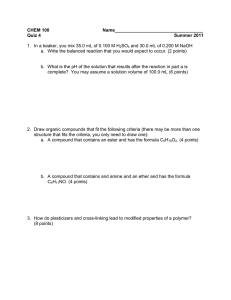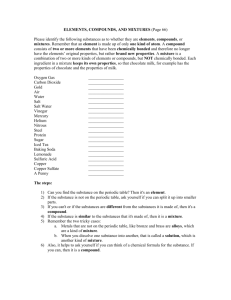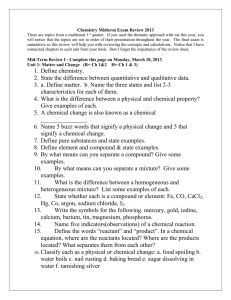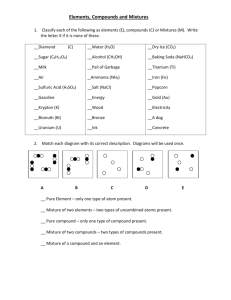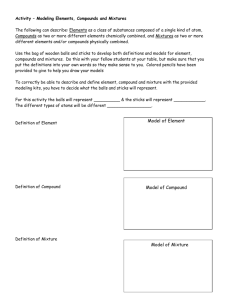Organic Qualitative Analysis
advertisement
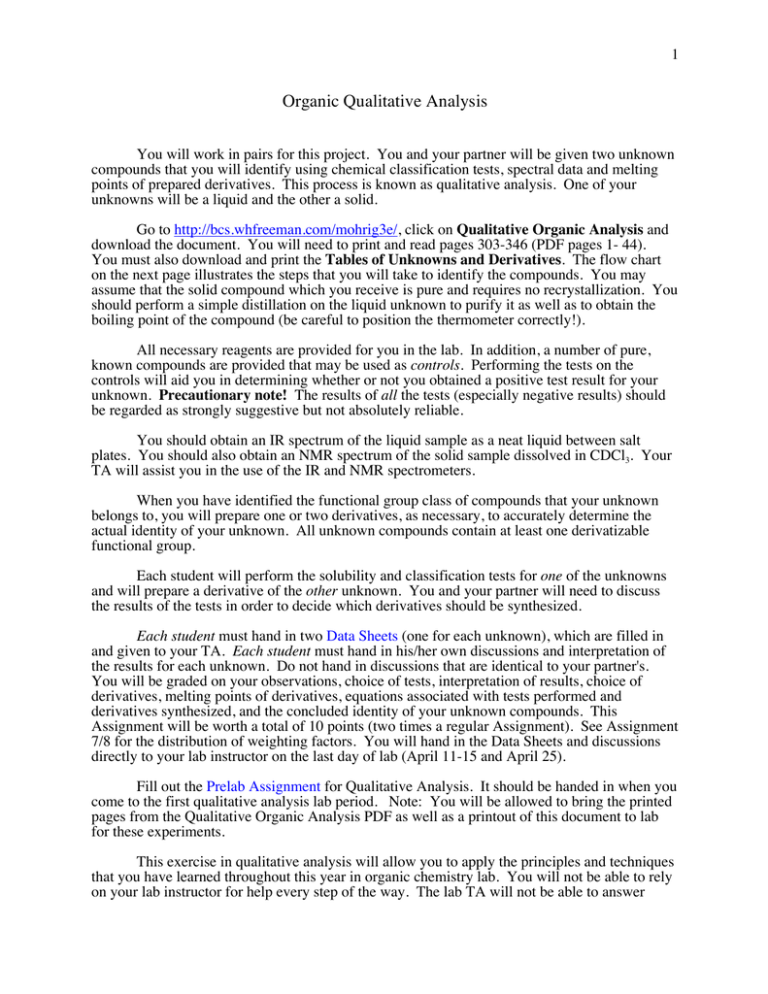
1 Organic Qualitative Analysis You will work in pairs for this project. You and your partner will be given two unknown compounds that you will identify using chemical classification tests, spectral data and melting points of prepared derivatives. This process is known as qualitative analysis. One of your unknowns will be a liquid and the other a solid. Go to http://bcs.whfreeman.com/mohrig3e/, click on Qualitative Organic Analysis and download the document. You will need to print and read pages 303-346 (PDF pages 1- 44). You must also download and print the Tables of Unknowns and Derivatives. The flow chart on the next page illustrates the steps that you will take to identify the compounds. You may assume that the solid compound which you receive is pure and requires no recrystallization. You should perform a simple distillation on the liquid unknown to purify it as well as to obtain the boiling point of the compound (be careful to position the thermometer correctly!). All necessary reagents are provided for you in the lab. In addition, a number of pure, known compounds are provided that may be used as controls. Performing the tests on the controls will aid you in determining whether or not you obtained a positive test result for your unknown. Precautionary note! The results of all the tests (especially negative results) should be regarded as strongly suggestive but not absolutely reliable. You should obtain an IR spectrum of the liquid sample as a neat liquid between salt plates. You should also obtain an NMR spectrum of the solid sample dissolved in CDCl3. Your TA will assist you in the use of the IR and NMR spectrometers. When you have identified the functional group class of compounds that your unknown belongs to, you will prepare one or two derivatives, as necessary, to accurately determine the actual identity of your unknown. All unknown compounds contain at least one derivatizable functional group. Each student will perform the solubility and classification tests for one of the unknowns and will prepare a derivative of the other unknown. You and your partner will need to discuss the results of the tests in order to decide which derivatives should be synthesized. Each student must hand in two Data Sheets (one for each unknown), which are filled in and given to your TA. Each student must hand in his/her own discussions and interpretation of the results for each unknown. Do not hand in discussions that are identical to your partner's. You will be graded on your observations, choice of tests, interpretation of results, choice of derivatives, melting points of derivatives, equations associated with tests performed and derivatives synthesized, and the concluded identity of your unknown compounds. This Assignment will be worth a total of 10 points (two times a regular Assignment). See Assignment 7/8 for the distribution of weighting factors. You will hand in the Data Sheets and discussions directly to your lab instructor on the last day of lab (April 11-15 and April 25). Fill out the Prelab Assignment for Qualitative Analysis. It should be handed in when you come to the first qualitative analysis lab period. Note: You will be allowed to bring the printed pages from the Qualitative Organic Analysis PDF as well as a printout of this document to lab for these experiments. This exercise in qualitative analysis will allow you to apply the principles and techniques that you have learned throughout this year in organic chemistry lab. You will not be able to rely on your lab instructor for help every step of the way. The lab TA will not be able to answer 2 questions such as “what test should I do next?” and “is this a positive or negative result?” both because s/he could inadvertently steer you in the wrong direction and because you must learn to trust your own judgment and make your own decisions in a problem solving process such as this. Flow Chart for Identification of Organic Compounds Observations of physical properties Liquid Solid Melting point detn. Boiling point detn. Ignition Test Beilstein test for Halogens Solubility tests Functional group classification tests Solid Spectral Analysis Liquid NMR spectrum Derivative(s) synthesis IR spectrum General Notes Only de-ionized water (from the white taps) should be used throughout the qualitative analysis procedures. Impurities in tap water could lead to “false positive” results. One drop of a liquid is equivalent to approximately 10-20 mg of a solid. When using a medicine dropper, you can assume that 20 drops is approximately equivalent to 1 mL. When using a Pasteur pipet, between 30 and 40 drops is equivalent to 1 mL. ★It is a good idea to double the amounts called for in the text when preparing your derivatives. 3 Ignition Test The ignition test, found on p. 331, will give you an indication as to whether or not your unknown compound is aromatic. Beilstein Test for Halogen You must perform the Beilstein test for halogens as described on p. 335. Additional notes on the solubility tests (pp 309-314) 1. If a reaction occurs when a solvent is added to a compound, as evidenced by a color change for instance, the compound is considered to be soluble in that solvent. 2. Even if your compound appears not to dissolve in water, it is a good idea to check the pH of the supernatant. A small amount of the compound may have dissolved and altered the pH. 3. If any amount of the compound appears to dissolve in a particular solvent, consider it to be soluble in that solvent. Refluxing procedures When a reaction mixture must be refluxed on a micro- or small scale, three options are available to you. 1) Obtain a 5 mL long-neck round bottom flask. Wrap a cold, wet paper towel around the neck, which will serve as the condenser. 2) Obtain a 5 mL long-neck round bottom flask and a microscale chromatography column. Attach the column to the flask with a rubber connector (from your microscale kit). The column will serve as an air-cooled condenser. 3) Obtain a 10 mL round bottom flask with a 19/22 ground glass connection. Attach a condenser from your drawer and run water through it. A note on the tests for Alkenes (p. 329) Dichloromethane is a suspected carcinogen and has harmful effects on the ozone layer of the atmosphere. We are limiting the use of this solvent in the teaching labs, and therefore the bromine reagent for this test will not be available. You may use the other test for alkenes, Oxidation with Potassium Permanganate, described on pp 329-330. Silver Nitrate Test: An additional test for the presence of halides (p. 335) Dissolve 1 drop or 10 mg of the compound to be tested in a drop or two of ethanol. Add 1 mL of 0.1 M silver nitrate in ethanol. The formation of a precipitate is a positive indication of the presence of halide. If there is no reaction at room temperature within 5 minutes, heat the mixture to the boiling point in a water bath for 3-4 minutes. If a precipitate forms, note its color. Silver iodide is yellow, whereas silver chloride and silver bromide are white. Add 2 drops of 1 M nitric acid. If the precipitate dissolves, it is not a silver halide (some organic acids produce insoluble silver salts that will dissolve in nitric acid). For reference, try the test on bromocyclohexane, bromobutane, 2-chloro-2-methyl propane (t-butyl chloride), and chlorobenzene. Silver nitrate reacts instantaneously with compounds that react quickly with ethanol to produce halide ions. Other compounds react with silver nitrate because they easily form carbocations in an SN1 process. The table on the next page summarizes the reactions of various halides (X = Cl, Br or I) with ethanolic silver nitrate. The overall reaction is: RX + Ag+ EtOH ROCH2CH3 + AgX (s) + alkenes 4 Reacts at room temp Reacts at higher temp No reaction RCH=CHCH2X R3CX RI RBr RCH2Cl R2CHCl RCHBr2 ArX RCH=CHX HCCl3 O O2N RCCl X NO2 ArCH2X O R C CH2X The Hinsberg Test for Amines (p. 330) Read the paragraph on page 330 labeled Amines. The following test should distinguish between primary, secondary and tertiary amines: Place 100 mg or 8 drops of amine in a 13x100 mm test tube, add 6 drops of benzenesulfonyl chloride and 2 mL of methanol. Heat the mixture to just below the boiling point (in a hot water bath), cool, and add 4 mL of 6 M sodium hydroxide. Shake the mixture constantly for 5 minutes. Allow the mixture to stand for 10 minutes with occasional shaking. Cool the mixture, then add 6 M hydrochloric acid dropwise with stirring until the pH is acidic. If a precipitate is seen, the amine is either primary or secondary. If no precipitate is seen, either the amine is tertiary, or the compound being tested is not an amine. If a precipitate is present, collect it by vacuum filtration and wash with water. Place this solid in a reaction tube and add 3 mL of 2.5 M sodium hydroxide. Heat to 50°, shaking the tube vigorously for 2 minutes. If the precipitate dissolves, the amine is primary. If it does not dissolve, it is secondary. The Hinsberg test is based on the ability of benzenesulfonyl chloride to form sulfonamides with primary and secondary amines. In general, tertiary amines do not react with benzenesulfonyl chloride because they lack an acidic hydrogen. Sulfonamides that are formed from primary amines have an acidic hydrogen and are therefore soluble in basic solution. O S O Cl + H2NR + NaOH S O O + NaCl + H2O N R O O S H O H + NaOH N R S O Na + H2O N R Sulfonamides formed from secondary amines are insoluble in base because they lack this acidic hydrogen: 5 O S O R + NaOH N No Reaction R The Ferrous Hydroxide Test for a Nitro Group Although nitro compounds will not be issued as distinct unknowns, many of the unknowns may have a nitro group as a secondary functional group. The presence of a nitro group in an unknown compound may be determined by means of infrared spectroscopy. The nitro group gives two strong bands near 1560 cm-1 and 1350 cm-1. Most nitro compounds will oxidize ferrous hydroxide to ferric hydroxide, which is a redbrown solid: RNO2 + 6 Fe(OH)2 + 4 H2O → RNH2 + 6 Fe(OH)3 red-brown ppt. Prepare 25 mL of deoxygenated water by boiling it on a hot plate. Dissolve 1.25 g of ferrous ammonium sulfate hexahydrate in this boiled water. In a small test tube, place 1 drop of liquid or 10 mg of solid unknown and 1.5 mL of the freshly prepared 5% aqueous solution of ferrous ammonium sulfate. [Note: You may share your remaining ferrous ammonium sulfate solution with another pair of students.] Mix the solution well and add first one drop of 1.5 M sulfuric acid, then 1 mL of 2 M potassium hydroxide in methanol. Stopper the test tube and shake it vigorously. The appearance of a red-brown precipitate of ferric hydroxide within one minute is a positive test. Almost all nitro compounds give a positive test within 30 seconds. The speed with which the nitro compound is reduced depends on its solubility. A negative test is indicated by a greenish precipitate. Carboxylic Acid Derivatives (pp 342-345) Use 1 mL of thionyl chloride instead of 0.3 mL. Care should be taken when using thionyl chloride. Read the hazards listed on the bottom of p. 342 carefully. Wear gloves and work in a fume hood. Do not carry an uncapped bottle or flask that contains thionyl chloride away from a fume hood. In Step 2: Preparation of Anilides and Toluidides (p. 344), follow the “dichloromethane-free” procedure described below: Dissolve 0.5 mL of aniline or 0.5 g of 4-toluidine in 9 mL of toluene, and carefully (by drops and with stirring) add it to the cooled acyl chloride reaction mixture. Warm the mixture on a steam bath. Wash the mixture (in either a separatory funnel or centrifuge tube) with the following solutions in the order written: 3 mL water 3 mL of 1.5 M HCl solution 3 mL of 2.5 M NaOH solution 3 mL water Dry the toluene layer over calcium chloride or sodium sulfate. Filter off the drying agent and collect the filtrate in a side-arm flask. In a fume hood, remove the solvent by evaporation under vacuum. Recrystallize the solid residue in the flask using water or an ethanol-water mixture. See p. 7 of this document for a table of the Toluidide derivatives (they are missing from the Appendix pages at the website). Amine Derivatives There are three options available for making amine derivatives. 6 Benzamides Dissolve 0.15 g of amine in 1.5 mL of pyridine (Caution: Toxic and unpleasant odor. Wear gloves and use only in fume hood.) and 3.0 mL of toluene in a 10 mL round-bottomed flask. Add 0.3 mL of benzoyl chloride (Caution: Lachrymator and skin irritant. Use only in fume hood.) to the flask. Attach a condenser fitted with a drying tube to the flask. Heat the reaction mixture on a steam bath or in a boiling water bath for 20 minutes, and then pour it into 20 mL of water. Transfer half of the mixture to a centrifuge tube with a tight fitting cap. Remove the lower aqueous phase with a Pasteur pipet, leaving the toluene layer in the centrifuge tube. Add the rest of the water/toluene mixture and remove the lower aqueous phase. Wash the toluene layer with 5 mL of 0.5 M Na2CO3 solution (Caution: Foaming.) Dry the organic layer with anhydrous sodium sulfate and remove the solvent by evaporation. Recrystallize the crude benzamide from ethanol or an ethanol/water mixture. Primary and secondary amines form solid benzamides upon reaction with benzoyl chloride: O O CCl + RNH2 CNHR + HCl Benzenesulfonamides Place 0.3 g of the amine in a dry test tube, then add 0.3 mL of benzenesulfonyl chloride (Caution: Corrosive, lachrymator. Wear gloves and use only in fume hood.) and 6 mL of 2.5 M NaOH solution. Close the test tube with a rubber stopper and shake it intermittently for 3-5 minutes. Cautiously, acidify the reaction mixture with 6 M HCl to a pH of 5. Collect the crystals by vacuum filtration on a Hirsch funnel and wash them thoroughly with water. Recrystallize the product from an ethanol/water mixture. Primary and secondary amines react with benzensulfonyl chloride as described earlier in the discussion of the Hinsberg test. Picrates Dissolve 0.15 g of the unknown amine in 5 mL of ethanol; if the amine does not dissolve entirely, use the saturated solution for the preparation of the derivative. Add this amine solution to 5 mL of saturated ethanolic picric acid solution (Caution! Dry picric acid is explosive when it is rapidly heated or subjected to a sharp blow. You will use a saturated solution of picric acid in ethanol, which can be handled safely.) Heat the reaction mixture to boiling on a steam bath. Cool the solution slowly, and collect the precipitate by vacuum filtration. Wash the crystals with 1-2 mL of cold ethanol. Recrystallization is not usually necessary. Picric acid is a strong acid (pKa = 0.25) that will form crystalline compounds with primary, secondary and tertiary amines. The reaction shown below illustrates the addition of picric acid to a tertiary amine. The picrates have convenient, sharp melting points. R3NH+ O– OH O2N NO2 O2N NO2 + R3N NO2 NO2 7 Ester Derivatives Ester derivatives can be prepared by hydrolyzing the compound to the parent carboxylic acid and alcohol. See p. 334 for the hydrolysis procedure. The melting point of the carboxylic acid can then be obtained. You might also want to make a derivative of this carboxylic acid. Byproducts Jars Eight different Byproducts jars will be available in the yellow dispensing hood. Signs will be posted in the hood that indicate which jar should be used for the disposal of waste from each test and derivative synthesis. Please read these signs carefully and find the appropriately labeled bottle. If you have any questions about how to properly dispose of a chemical, consult with your lab instructor. Melting points for Toluidide derivatives of Carboxylic Acids Compound Formic acid Acetic acid Propanoic acid 2-Chloropropanoic acid Dichloroacetic acid 2-Bromopropanoic acid Octanoic acid Decanoic acid Dodecanoic acid (lauric acid) 3-Phenylpropanoic acid Trichloroacetic acid 2-Butenoic acid Phenylacetic acid 2-Methylbenzoic acid 3-Methylbenzoic acid (1)- or (2)-Mandelic acid Benzoic acid Maleic acid Cinnamic acid (trans) Decanedioic acid (sebacic acid) 2-Chlorobenzoic acid 3-Nitrobenzoic acid 2-Aminobenzoic acid Diphenylacetic acid Benzilic acid Hexanedioic acid 2-Hydroxybenzoic acid (salicylic acid) 4-Methylbenzoic acid 4-Methoxybenzoic acid Butandioic acid (succinic acid) Phthalic acid 4-Hydroxybenzoic acid 4-Nitrobenzoic acid Toluidide m.p. 53 126 124 124 153 125 70 78 87 135 113 132 136 144 118 172 158 142 168 201 131 162 151 172 190 239 156 160 186 255(di) 201(di) 204 204 8 Peer Evaluation Form for the Performance Grade Rate your partner using a whole number from 1–5 on overall performance during the project. This form will be kept strictly confidential and will not be shown to anyone. Bring this sheet with you to the last lab period of the semester and give it to your TA. Partner’s name Rating _______________________________ ___________ _______________________________ ___________


